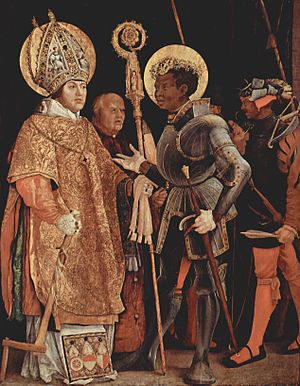Erasmus Mauritius blackboard

|
| Erasmus Mauritius blackboard |
|---|
| Matthias Grünewald , 1517–23 |
| Oil on fir wood |
| 226 × 176 cm |
| Alte Pinakothek (Munich) |
The Erasmus Mauritius board is one of the most important works by Matthias Grünewald . It was created between 1520 and 1524 for the redesigned and newly consecrated New Collegiate Church at the Prince Archbishop's residence in Halle (Saale) . After the abolition of the monastery in the course of the Reformation , the tablet was transferred to Aschaffenburg along with other works of art . Today the painting is in the Alte Pinakothek in Munich .
Image description
The holy Erasmus in full bishop ornat is a portrait of the Archbishop of Mainz and Magdeburg , Cardinal Albrecht of Brandenburg , who had ordered the picture in Green Forest. The panel shows an - unhistorical - meeting of Saint Mauritius , the leader of the Thebaic Legion , with Saint Erasmus. Saint Mauritius was the patron of the New Abbey in Halle, the Archbishopric of Magdeburg and the Holy Roman Empire , and Saint Erasmus was the patron saint of the House of Brandenburg-Hohenzollern , from whom Albrecht von Brandenburg descended. The spindle that Erasmus holds in his right hand is the instrument of torture: his intestines were pulled out of his body with a ship's winch.
background
Representation
Details such as the figurative work of the miter and the embroidered half-figure of a Maria Magdalena on Erasmus's robe collar are reproduced with the same care as the somewhat slack physiognomy of the prince-bishop . Grünewald does not appear here as the painter of emotional ecstasy; he carried out the commission with artificial perfection. For Mauritius, the " Mohren ", a model was not available. Grünewald had to resort to a Mauritius statue .
Political statement
In view of the approaching Reformation, Albrecht von Brandenburg intensified the veneration of saints as a link between earthly persons and powers to heavenly patrons. The identification of his own person with St. Erasmus contrasts with the attributes of St. Mauritius that relate him to Emperor Charles V : he wears the splendid armor that Karl wore at his coronation in Aachen in October 1520 and later given to Albrecht as a gift , and a wreath adorned with precious stones. In this way, symbolically, the Primate Germaniae and the Roman-German Emperor , the patron of the church , meet at eye level.
Web links
- Basic data (pinakothek.de)
- History and description ( House of Bavarian History )

